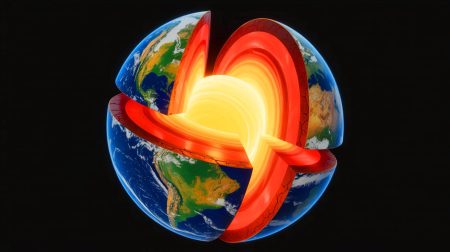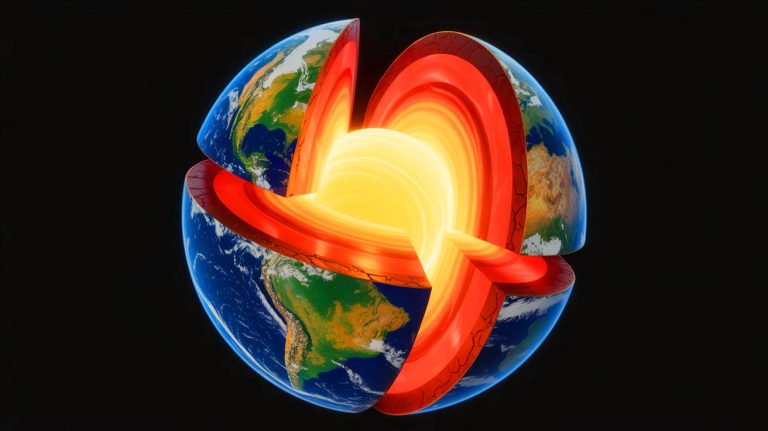| IN A NUTSHELL |
|
The Earth, an ever-dynamic planet, continues to astonish scientists with its hidden movements. While it is common knowledge that continents drift due to plate tectonics, new research brings a more dramatic phenomenon to light: true polar wander (TPW). This event involves the entire solid shell of Earth—the mantle and crust—sliding over the liquid outer core, shifting the planet’s orientation. Recent studies now provide compelling evidence that this occurred around 84 million years ago. Such revelations not only ignite scientific curiosity but also challenge previous understandings of Earth’s stability and history.
What True Polar Wander Really Means
Picture the Earth as a gigantic spinning top, completing one rotation every 24 hours. Beneath the surface lies a complex structure: a solid inner core, a swirling liquid outer core, and a solid mantle topped by the crust. While the inner core remains fixed, the crust and mantle are not permanently locked in place. Due to the liquid nature of the outer core, these solid layers can move together if the forces are sufficient. This motion is what scientists refer to as true polar wander.
True polar wander involves the entire crust and mantle reorienting around the spin axis. As dense structures like sinking ocean plates and giant volcanoes drift toward the equator, the orientation of the Earth shifts. Remarkably, this motion occurs without altering the planet’s magnetic field, which is generated deep within by swirling currents of molten iron and nickel. Rocks across the globe record Earth’s magnetic history. When sedimentary rocks form, tiny magnetic crystals inside them align with the local magnetic field, preserving the direction and tilt of Earth’s magnetic field at that time. These “fossil compasses” serve as essential clues for scientists trying to reconstruct the positions of the poles millions of years ago.
The Great 84-Million-Year Debate
The possibility of a large-scale TPW event occurring during the Late Cretaceous has been a topic of heated debate among geologists for decades. Earlier research on Italian limestone known as the Scaglia Rossa argued against such an event, citing limited and outdated data. These studies lacked modern analytical tools, resulting in an incomplete understanding of the period from 90 to 75 million years ago.
However, recent efforts by scientists such as Ross Mitchell and Joe Kirschvink have taken a fresh approach. By examining the same Italian limestones, which span the Apennine Mountains and date back to 145.5 to 65.5 million years ago, they uncovered a more detailed magnetic history. Interestingly, younger rocks in this region have even been linked to the asteroid impact that led to the demise of the dinosaurs. The magnetic minerals in these rocks are fossils of bacteria that produced chains of magnetite crystals, providing highly reliable data for paleomagnetic studies.
Gathering Mountains of Evidence
In a quest for clarity, the research team collected over 1,000 samples from overlapping rock sections to ensure the accuracy and reproducibility of their findings. Using advanced paleomagnetic techniques, they carefully demagnetized the rocks, measured their magnetic signals, and eliminated potential errors. This comprehensive data collection exceeded the scope of earlier studies.
The meticulous work revealed a remarkable ~12-degree tilt of Earth’s crust and mantle around 84 million years ago. However, the story didn’t end there. Following this initial tilt, Earth corrected itself, swinging back nearly to its original orientation. This cosmic “yo-yo” motion involved almost 25 degrees of movement over approximately five million years, marking the most recent large-scale TPW event ever documented. These findings, published in Nature Communications, signify a major breakthrough in understanding Earth’s rotational dynamics and challenge the long-standing notion of a stable spin axis over the past 100 million years.
Why It Matters for Understanding Earth’s History
Confirming a large-scale true polar wander event carries significant implications for how we comprehend Earth’s past. It suggests that major shifts of the entire surface can occur without the need for earthquakes, volcanoes, or asteroid impacts as catalysts. Instead, internal forces, such as shifting masses within the mantle, can trigger a slow yet monumental reorientation.
This discovery implies that Earth’s stability is not as absolute as once thought. Over tens of millions of years, the planet can lurch and then right itself. Such newfound evidence aids in explaining shifts in climate, sea levels, and even the distribution of life across ancient Earth. For decades, skepticism about true polar wander hinged on incomplete or outdated data. Now, with high-resolution magnetic records and rigorous scientific analysis, there is strong support that Earth’s rocky skin can, and indeed did, tip and sway through deep time. As further research delves into older rocks using modern techniques, we may find that Earth’s history includes more dramatic twists and turns than previously imagined.
The study of true polar wander challenges us to reconsider Earth’s history and the forces that shape our planet. By unraveling this cosmic dance, scientists not only address long-standing debates but also open new avenues for exploration. As we continue to investigate the mysteries of Earth’s past, one must wonder: What other hidden movements and transformations await discovery beneath our feet?
Did you like it? 4.7/5 (23)









Wow, 25 degrees? That’s quite a tilt! 😲